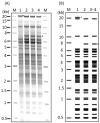Phenotypic Characterization of Recombinant Marek's Disease Virus in Live Birds Validates Polymorphisms Associated with Virulence
- PMID: 38005939
- PMCID: PMC10674313
- DOI: 10.3390/v15112263
Phenotypic Characterization of Recombinant Marek's Disease Virus in Live Birds Validates Polymorphisms Associated with Virulence
Abstract
Marek's disease (MD) is a highly infectious lymphoproliferative disease in chickens with a significant economic impact. Mardivirus gallidalpha 2, also known as Marek's disease virus (MDV), is the causative pathogen and has been categorized based on its virulence rank into four pathotypes: mild (m), virulent (v), very virulent (vv), and very virulent plus (vv+). A prior comparative genomics study suggested that several single-nucleotide polymorphisms (SNPs) and genes in the MDV genome are associated with virulence, including nonsynonymous (ns) SNPs in eight open reading frames (ORF): UL22, UL36, UL37, UL41, UL43, R-LORF8, R-LORF7, and ICP4. To validate the contribution of these nsSNPs to virulence, the vv+MDV strain 686 genome was modified by replacing nucleotides with those observed in the vMDV strains. Pathogenicity studies indicated that these substitutions reduced the MD incidence and increased the survival of challenged birds. Furthermore, using the best-fit pathotyping method to rank the virulence, the modified vv+MDV 686 viruses resulted in a pathotype similar to the vvMDV Md5 strain. Thus, these results support our hypothesis that SNPs in one or more of these ORFs are associated with virulence but, as a group, are not sufficient to result in a vMDV pathotype, suggesting that there are additional variants in the MDV genome associated with virulence, which is not surprising given this complex phenotype and our previous finding of additional variants and SNPs associated with virulence.
Keywords: Marek’s disease; single-nucleotide polymorphisms; viral genome; virulence.
Conflict of interest statement
The authors declare no conflict of interest.
Figures




Similar articles
-
Comparative analysis of Marek's disease virus (MDV) glycoprotein-, lytic antigen pp38- and transformation antigen Meq-encoding genes: association of meq mutations with MDVs of high virulence.Vet Microbiol. 2004 Sep 8;102(3-4):147-67. doi: 10.1016/j.vetmic.2004.06.007. Vet Microbiol. 2004. PMID: 15327791
-
Correlation between Marek's disease virus pathotype and replication.Avian Dis. 2014 Jun;58(2):287-92. doi: 10.1637/10678-092513-Reg.1. Avian Dis. 2014. PMID: 25055634
-
Pathogenicity and Pathotype Analysis of Henan Isolates of Marek's Disease Virus Reveal Long-Term Circulation of Highly Virulent MDV Variant in China.Viruses. 2022 Jul 27;14(8):1651. doi: 10.3390/v14081651. Viruses. 2022. PMID: 36016273 Free PMC article.
-
Classification of Marek's disease viruses according to pathotype: philosophy and methodology.Avian Pathol. 2005 Apr;34(2):75-90. doi: 10.1080/03079450500059255. Avian Pathol. 2005. PMID: 16191686 Review.
-
Latest Insights into Unique Open Reading Frames Encoded by Unique Long (UL) and Short (US) Regions of Marek's Disease Virus.Viruses. 2021 May 25;13(6):974. doi: 10.3390/v13060974. Viruses. 2021. PMID: 34070255 Free PMC article. Review.
Cited by
-
Genomic characteristics and distinctive genetic polymorphisms of Marek's disease virus strains circulating in Japan.J Vet Med Sci. 2025 May 15;87(5):517-531. doi: 10.1292/jvms.25-0011. Epub 2025 Apr 3. J Vet Med Sci. 2025. PMID: 40175154 Free PMC article.
References
-
- Schat K.A., Nair V. Marek’s disease. In: Swayne D.E., Glisson J.R., McDougald L.R., Nolan L.K., Suarez D.L., Nair V.L., editors. Diseases of Poultry. 13th ed. Wiley-Blackwell; New York, NY, USA: 2013. pp. 515–552.
-
- Biggs P.M. The history and biology of Marek’s disease virus. In: Hirai K., editor. Current Topics in Microbiology and Immunology. Springer; Berlin, Germany: 2001. pp. 1–24. - PubMed
-
- Morrow C., Fehler F. Marek’s disease: A worldwide problem. In: Davison F., Nair V., editors. Marek’s Disease: An Evolving Problem. Elsevier; Amsterdam, The Netherlands: 2004. pp. 49–61.
MeSH terms
Grants and funding
LinkOut - more resources
Full Text Sources
Miscellaneous

